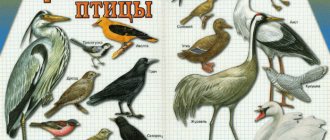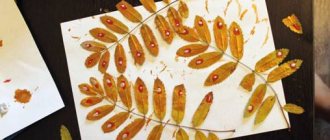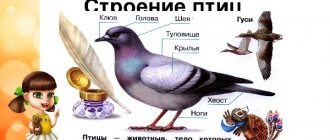MAGAZINE Preschooler.RF
Goal: 1. To form a generalized idea of wintering and migratory birds, to learn to distinguish them according to an essential feature: the ability to satisfy the need for food; deepen the understanding of the reasons for the departure of birds (disappearance of the main food, freezing of reservoirs, land, death of vegetative parts of plants), classify birds into wintering (crow, jackdaw, sparrow, tit) and migratory (swallow, rook, duck, swift, starling) based on the establishment connections between the nature of food and the possibility of obtaining it, enrich the vocabulary by introducing words: food, migratory, wintering; cultivate a love for birds and a desire to help them in winter conditions. 2. Teach children to describe birds by characteristic features and descriptions, to recognize them. 3. Learn to make a fairy bird, decorate it with decorative elements; develop spatial and figurative thinking.Preliminary work: Bird watching on a walk; Reading books by natural history writers (Charushin, Prishvin, Bianki); Examination of color illustrations, albums about birds of the Middle Zone; Didactic game “What kind of bird?”
Equipment: Tables with wintering and migratory birds; Box feeders; Sunflower seeds, millet, pieces of lard; Glasses of water of different temperatures; Landscape sheet, colored blanks of square, rectangular and triangular shapes, colored stripes, colored feathers, pencil, scissors, glue, brush, oilcloth, rag, tray; Audio cassette “Voices of birds”.
Expected result: formed ideas about birds, enrichment of children's vocabulary.
Progress of the lesson: 1. The teacher invites the children to look at tables depicting wintering and migratory birds. Questions: What birds are you familiar with? What birds have you seen on your property or in the forest in winter? (sparrows, jackdaws, crows, tits, pigeons, magpies, woodpeckers). What are the names of the birds that stay with us for the winter? (wintering, sedentary). What birds haven't been seen lately? (swallows, rooks, starlings, ducks, swifts). Where have these birds gone? (Fly away to warmer climes). What are the names of the birds that fly away from us for the winter? (migratory) Why do you think migratory birds fly away? (they are afraid of the cold) Remember what birds eat? (insects hid, so the birds that fed on insects are the first to fly away, then those that eat the fruits and seeds of plants, since the harvest in the gardens and fields is harvested. Ducks and geese fly away later. They live until reservoirs will freeze.
— Migratory birds are not adapted to stock up on food for the winter and obtain it in winter conditions. In the summer they live with us, build nests, and raise chicks. With the onset of cold weather, they fly away to hot countries and return to their native lands in the spring. - Why do you think wintering birds (sparrows, pigeons, tits, jackdaws, magpies, woodpeckers, crows) live with us all year round? These birds are not afraid of frost and manage to get food even in the coldest winters. They look for insects that have hidden in cracks in tree bark, cracks in houses and fences, and eat fruits and seeds of deciduous and coniferous plants. And nuthatches and tits are looking for reserves that they made in the fall. And yet it is very difficult for birds in winter. It is especially difficult to find food during snowfalls, blizzards and severe frosts. In such weather, birds often go hungry and even die from cold and hunger. Birds come closer to people's homes in winter. And you and I must help our feathered friends survive the winter. Seeds of various plants are suitable for feeding birds - hemp, sunflower, melon, pumpkin, watermelon, and many weeds. But only sparrows and buntings peck at oats and millet. Tits are very fond of pieces of unsalted lard.
Today, when you and I go for a walk, we will hang these feeders and put food in them for different birds. And maybe by doing this we will save more than one bird’s life. And in the summer the birds will help people. They will eat insect pests and continue to protect trees in gardens, parks, and public gardens from them.
Physical education lesson The forest and fields are covered with snow, The earth sleeps soundly under the snowdrifts. The birds are looking and looking for something to profit from. For the long winter in our forest, We will prepare food for the birds. Come, birds, you come here to feed!
2. The teacher asks the children to guess what kind of bird it is (children can learn the riddles in advance):
A little boy, in a gray yarmichishka, jumps, darts, collects crumbs. (sparrow)
In a red embroidered hat, in a black caftan, he is famous in the family for his funny forest song. What kind of song is beauty? Knock-knock-knock, yes tra-ta-ta! (woodpecker)
Apples on the branches in winter! Collect them quickly! And suddenly the apples fluttered, After all, these are ... (bullfinches)
There is a palace on a pole, There is a singer in the palace, And his name is ... (starling)
Black, agile, Shouts “krak”, the enemy of worms. (rook)
Who on the tree, on the branch, is counting “kuckoo-ku-ku”? (cuckoo) You can use riddles - descriptions (appearance, what it eats, where it lives...) compiled by children.
3. The teacher shows the children an image of exotic tropical birds, invites them to look at the plumage, and asks how they are similar to a fairy-tale bird. Children cut out the head and torso from square and rectangular blanks. (The body of the bird can be drawn on the back of colored paper and cut out). The wings and tail are made from triangles, making zigzag or wavy cuts along the edge. Place the main parts on the sheet and stick them on. Then children select material to decorate the head, wings and tail. The colored strip is folded like an accordion, and a circle or oval, or a droplet-shaped figure is drawn on the top. They cut it out. Decoration elements can be of different sizes, colors, shapes. They can be glued on top of each other (a smaller element in the middle of a larger one). Children stick figured decorations on the wings, tail, head, thereby conveying the image of a fairy-tale bird. Result: Children, look at what different exotic birds we got. Each one is different from each other. Well done, thank you!
| Next > |
Lesson summary for the senior group on the topic: Birds
Lesson notes. Topic: “Let's talk about birds”
The summary is intended for preschool teachers.
Objectives of the lesson: • deepen and expand children's knowledge about birds; • explain the reason for bird migration; • learn to distinguish birds from other animals; • enrich and activate children's speech; • Cultivate a kind, caring attitude towards feathered friends, a desire to help birds during a difficult period for them. Preliminary work: • bird watching on a walk;
• looking at illustrations with birds; • learning the outdoor game “Birder Catcher”; • asking riddles • reading fiction about birds. Progress of the lesson:
- Guys, guess who we will talk about today in class.
Riddle: “We differ in color, you will meet us in winter and summer. If we flap our wings, we will be in the blue sky. We can chirp, croak, sing and coo. You will feed us in winter. Children, who are we? name it." (birds) - What birds do you know? (children take turns naming one bird at a time) - Well done, you know a lot of birds. This means that it will not be difficult for you to guess my riddles. 1. How would a crown suit me? — The Crow croaked importantly 2. Who, without notes and without a pipe, is the best at trilling, more vocal, more tender? Who is this? (Nightingale) 3. If it wants, it will fly straight, If it wants, it hangs in the air, it falls like a stone from the heights, and in the fields it sings and sings. (Lark) 4. It flies all night - it gets mice. And it becomes light - Sleep flies into the hollow. (Owl). 5. If I knock, my head hurts, but if I don’t knock, I’m hungry. (Woodpecker). 6. Lives in the forest, Howls like a robber, People are afraid of him, And he is afraid of people. (Owl). 7. He knocks all the time, he hammers trees, but he doesn’t cripple them, he only heals them. (Woodpecker) 8. A spotted bird laid an egg in someone else’s nest. (Cuckoo). 9. In the summer they follow the plowman, but in the winter they leave screaming. (Rooks). 10. Stands on one leg, looks intently into the water. Poking at random with its beak - Looking for frogs in the river. A drop hung on my nose. Do you recognize? This is... (Heron). 11. And he doesn’t sing, And he doesn’t fly, Why then do they consider Him a bird? (Ostrich). 12. Who, without notes and without a pipe, plays trills best, more vocally, more tenderly? Who is this?.. (Nightingale). 13. The motley fidget, the long-tailed bird, the talkative bird, the most talkative. (Magpie) - What will happen if we don’t have birds? (children’s answers) - What can we do to prevent birds from disappearing? How can we help them? (build birdhouses, make feeders, etc.) So that flowering gardens do not die in vain from harmful insects. Always, at any time of the year. Take care of all kinds of birds, friends. — With the onset of cold weather in the fall, the migration of birds begins, this is how it is written in E. Blaginina’s poem: Soon white snowstorms will raise the snow from the ground. The cranes are flying away, flying away, flying away. You can’t hear the cuckoo in the grove, And the birdhouse is empty, The stork flaps its wings - It flies away, it flies away. A patterned leaf sways in a blue puddle on the water. A black rook and a black rook are walking in the garden, along the ridge. The rare rays of the sun, crumbling and turning yellow, The rooks are flying away, flying away, flying away. — Guys, what birds is this poem about? (about migratory birds) - The first to fly away from us are the fast-winged birds. These are swifts, swallows, starlings, larks. They fly away at the end of August, because... many insects disappear. These birds feed on insects and are called insectivores. — On the golden autumn days, the cranes gathered to fly away. They circled over their native swamp, gathered in schools, and headed to distant warm countries. The strongest one flies ahead - the leader. Wild geese and ducks fly away later than everyone else - when rivers and lakes freeze. These birds are called waterfowl. - Let's try to fly like the birds Fizminutka. The little birds were flying. How they flew All the people looked. As they sat down, all the people were amazed. They sat down, sat, soared, flew, and sang songs. - When will the birds return? (spring) - Let's play the game “The birds have flown!” and find out what birds will fly to us in the spring. I will read a poem, and you listen carefully and if you hear a word that does not name a bird, then you need to clap your hands. Birds have arrived: Pigeons, tits, Flies and swifts... (children clap, flies) And who are the flies? (insects) Birds arrived: Pigeons, tits. Storks, crows, Jackdaws, pasta! (children clap, pasta) Birds have arrived: Pigeons, tits, lapwings, siskins, jays and grass snakes. (children clap, snakes) Birds have arrived: Pigeons, tits, Seagulls, pelicans, Mikes and eagles. Pigeons, tits, herons, nightingales, perches and sparrows. (children clap, perches - fish) Birds have flown in: Pigeons, tits, Ducks, geese, owls, swallows, cows. (children clap, the cow is a beast) Birds have flown in: Pigeons, tits, lapwings, siskins, jackdaws and swifts Mosquitoes, cuckoos ... (children clap, mosquitoes are insects) Birds have arrived: Pigeons, tits, Jackdaws and swifts, Lapwings, siskins, Storks, cuckoos, Swans, starlings... Well done to all of you! — A bird is a beautiful creation of nature. Many songs, poems, legends, and fairy tales are written about birds. — Guys, what fairy tales do you know where birds are found? (children’s answers, the teacher adds) — I suggest playing the outdoor game “Birder Catcher.” The players choose the names of the birds whose calls they can imitate. They stand in a circle, in the center of which is a blindfolded birdcatcher. The birds walk, circle around the bird-catcher and say: In the forest, in the little wood, On the green oak tree, The birds sing merrily. Oh! The bird catcher is coming! The bird catcher claps his hands, the players stop in place, and the driver begins to look for birds. The one he finds imitates the call of the bird he has chosen. The birder guesses the name of the bird and the name of the player. The player becomes a bird catcher. Players should not hide behind objects encountered along the way. Players must stop in place exactly when signaled. “Not all birds fly away; there are those that stay with us for the winter. What are their names? (wintering, sedentary) -What wintering birds do you know? (they will list the wintering birds of our region). — Why do they say that winter is a difficult time for birds? (children's answers) - How can you take care of them in winter? (children's answers) - What can be used as food for birds in winter? (children's answers) - Indeed, winter is a difficult time for birds, especially if it is frosty and full of snow. Birds cannot find food under the snow. A hungry bird suffers greatly from the cold. Winter days are short, and in order to survive without freezing, you need to eat much more food than in summer. You need to support the birds, make feeders for them and don’t forget to bring food to them. This is a very useful thing. Relaxation. - The birds have flown. They are flying, flapping their wings (children raise their hands up and down) - The wind has risen, it is becoming more and more difficult for the birds to fly! - The rain wet the wings, the wings became heavy (children slowly raise their hands) - It’s very difficult for the birds. “But our birds are stronger than the mighty wind, stronger than the cold rain.” — The wind died down, it gave up. The sun came out. Tired birds fall to the ground. The flock settles down to rest (the children lie on their stomachs, arms to the sides) - Our birds are so tired that they can’t move! — Our birds have warmed up. The feathers have dried up. — The wings are resting. The sun warmed the wings, they became warm. - Legs are resting. The sun warmed my legs and my legs became warm. - The backs are resting. And the backs warmed up, became warm. - The heads warmed up, and they became warm. “It’s so good for our birds to rest.” - Thank you, you did a good job today. Some of the kids with their parents and you and I also made feeders. And now we will go outside together and hang them on a tree, and you promise that every day you will take out food and observe what birds fly to your feeders.
We recommend watching:
Summary of educational activities in the senior group “Journey to a Fairy Tale” Summary of a mathematics lesson for children of the senior orthopedic group Summary of educational and gaming activities in the senior group in the section of the “Childhood” program Synopsis of educational activities for the perception of music in the senior group of kindergarten
Similar articles:
Lesson in the senior group of kindergarten on the topic of February 23
Lesson notes for children of senior preschool age. Topic: Invisible air
Summary of organized educational activities for children of the senior group
Notes for mathematics classes in the senior group
Lesson summary on the topic “Reserve” in the senior group





